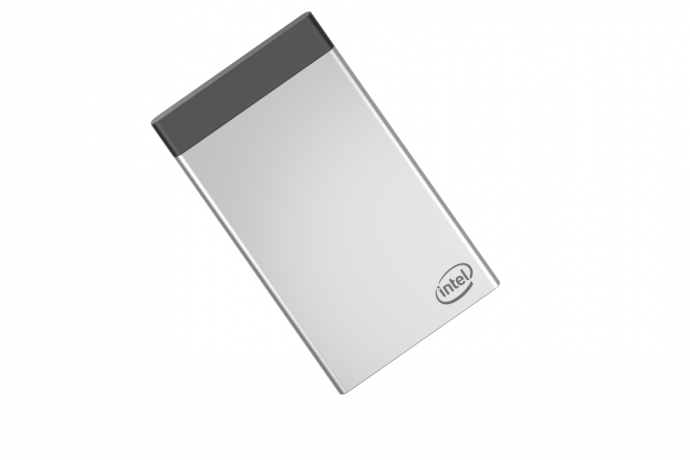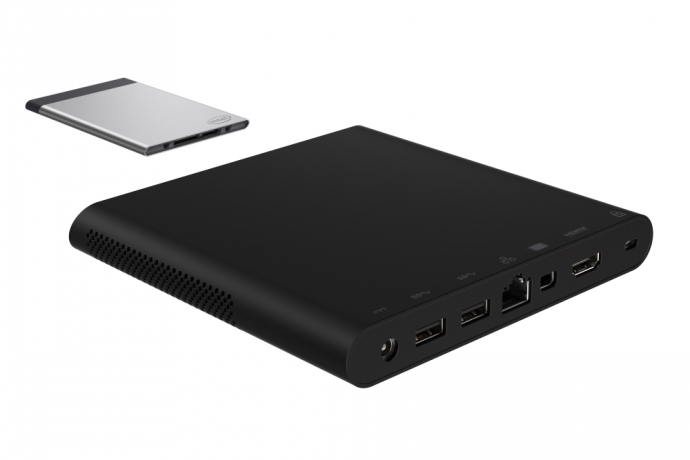Intel Displays Credit-Card Sized Compute Card At Computex 2017, Shipping Soon
Intel unveiled its credit card-sized Compute Card at CES earlier this year, and now at Computex, the company has brought us up to speed on the available SKUs and the release date.
The Compute Card comes packed with the full functionality of a standard computer, including an SoC, connectivity, storage, and memory in one slim device. The device slots into a range of devices from laptops, tablets, and AIOs to interactive refrigerators and IoT gateways. The devices can be ejected and replaced, thus decoupling compute from the device and allowing for easy upgrades as the card evolves into more powerful variants. That could also make for interesting new laptop platforms with longer shelf lives.
| Header Cell - Column 0 | 7th Gen Intel Core i5 vPro (i5-7Y57) | 7th Gen Intel Core i3 (m3-7Y30) | Pentium N4200 | Celeron N3450 |
|---|---|---|---|---|
| Model | CD1IV128MK | CD1M3128MK | CD1P64GK | CD1C64GK |
| Memory | 4GB DDR3 | 4GB DDR3 | 4GB DDR3 | 4GB DDR3 |
| Storage | 128GB Intel SSD | 128GB Intel SSD | 64GB eMMC | 64GB eMMC |
| Connectivity | Intel Wireless-AC 8265 (2×2 .11ac & Bluetooth 4.2) | Intel Wireless-AC 8265 (2×2 .11ac & Bluetooth 4.2) | Intel Wireless-AC 7265 (2×2 .11ac & Bluetooth 4.2) | Intel Wireless-AC 7265 (2×2 .11ac & Bluetooth 4.2) |
The Compute Card family offers processors that span from Core to Celeron and come in four SKUs. Each respective product has varying compute, storage, and connectivity options, though the processor serves as the only differentiation between the two high-end options. Aside from listing the processors, Intel hasn't given us an indication of performance.
Intel has signed on a bevy of partners to develop new products that leverage the device, including Contec, ECS, Foxconn, LG Display, MoBits Electronics, NexDock, Sharp, Seneca, SMART Technologies, Suzhou Lehui Display, and TabletKiosk. Many of these partners will have products on display at Computex 2017. Dell, HP, and Lenovo are also working on new products, but have yet to reveal any of the end devices.



Intel also released its Compute Card Device Design Kit, which is a set of guides and reference designs that simplify and speed up the product development process.
In many ways Intel's Compute Card signifies the company's continued push for product diversification as it delves into IoT, automated driving, and other lucrative climes. In this case, its efforts also further its objectives in the mobility space, as we can expect new laptops and AIOs to come to market with the new cards installed. The Compute Card will begin shipping in August 2017, but Intel hasn't revealed pricing info.
Get Tom's Hardware's best news and in-depth reviews, straight to your inbox.

Paul Alcorn is the Editor-in-Chief for Tom's Hardware US. He also writes news and reviews on CPUs, storage, and enterprise hardware.
-
TheRojakPlace The first that comes to mind is how much it looked like PCMCIA cards, when it's said to be inserted into laptops. History repeats! ??Reply -
bit_user Reply
No, these cards are more likely to contain the laptop's CPU, memory, and primary storage. The laptop would likely be just a shell containing battery, display, keyboard, trackpad, and maybe some additional storage.19755563 said:The first that comes to mind is how much it looked like PCMCIA cards, when it's said to be inserted into laptops. History repeats! ??
I don't really see this catching on as a way to have upgradable laptops, since these CPUs will be slower than most current laptop specs and the slot will just add bulk and cost. There would probably be other purposes for slotting these into a laptop or tablet shell, but those remain to be seen.
I highly doubt they're going to revive anything like a PCMCIA (AKA PC Card) slot, for these. Laptops are already too thin to accommodate it. -
AgentLozen ReplyBit_User said:No, these cards are more likely to contain the laptop's CPU, memory, and primary storage. The laptop would likely be just a shell containing battery, display, keyboard, trackpad, and maybe some additional storage.
I was wondering what this compute card was supposed to do, but the more I look at it, the more I think that you're right Bit_User. It seems like it's the computing guts that you can insert into a laptop shell. Every two years or so you could just replace the compute card and upgrade your laptop.
It's a neat idea, but I think it will only appeal to a niche market. -
bit_user Reply
I'm sure that's not the main point of it. This is like a more streamlined version of Raspberry Pi, where most of the ports are on whatever it's docked with.19757070 said:It seems like it's the computing guts that you can insert into a laptop shell. Every two years or so you could just replace the compute card and upgrade your laptop.
It's a neat idea, but I think it will only appeal to a niche market.
I'm sure they have various industrial & commercial applications in mind (some of their partners listed seem to be kiosk & electronic signage manufacturers). It remains to be seen how consumer-focused this will be. I wonder whether they see it as a mobile counterpoint to their NUC platform, or perhaps something more specialized. -
bigpinkdragon286 Actually, this seems more a blast from the past. The Pentium II slot CPUs were supposed to be user replaceable, upgradeable, and pair-able without the user having to open the chassis. While that never quite came to fruition, it looks like Intel never completely forgot the idea.Reply
